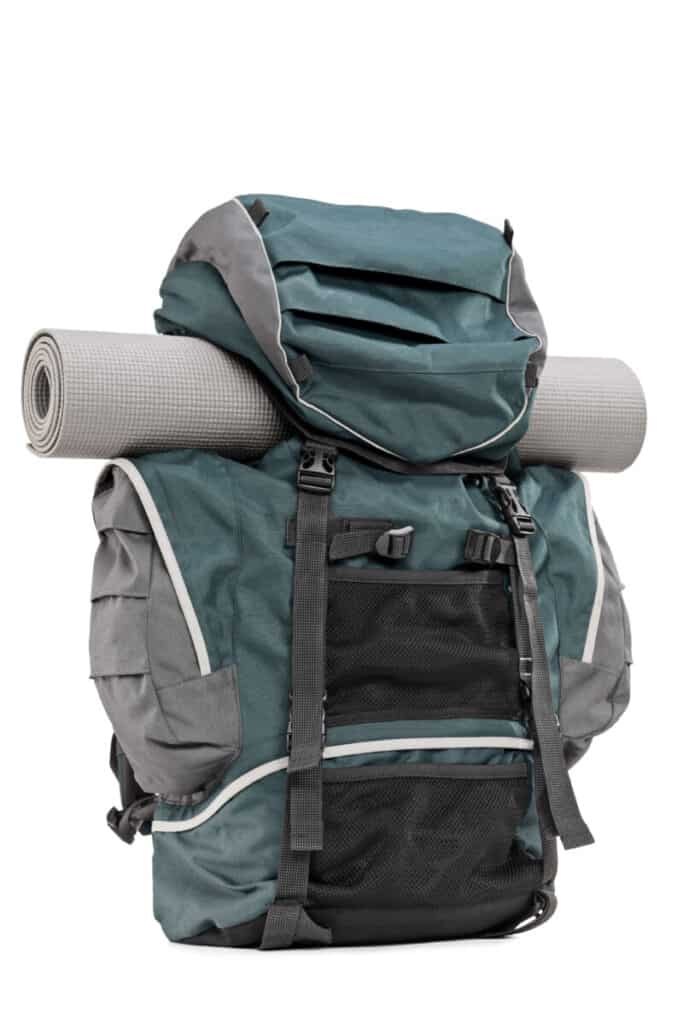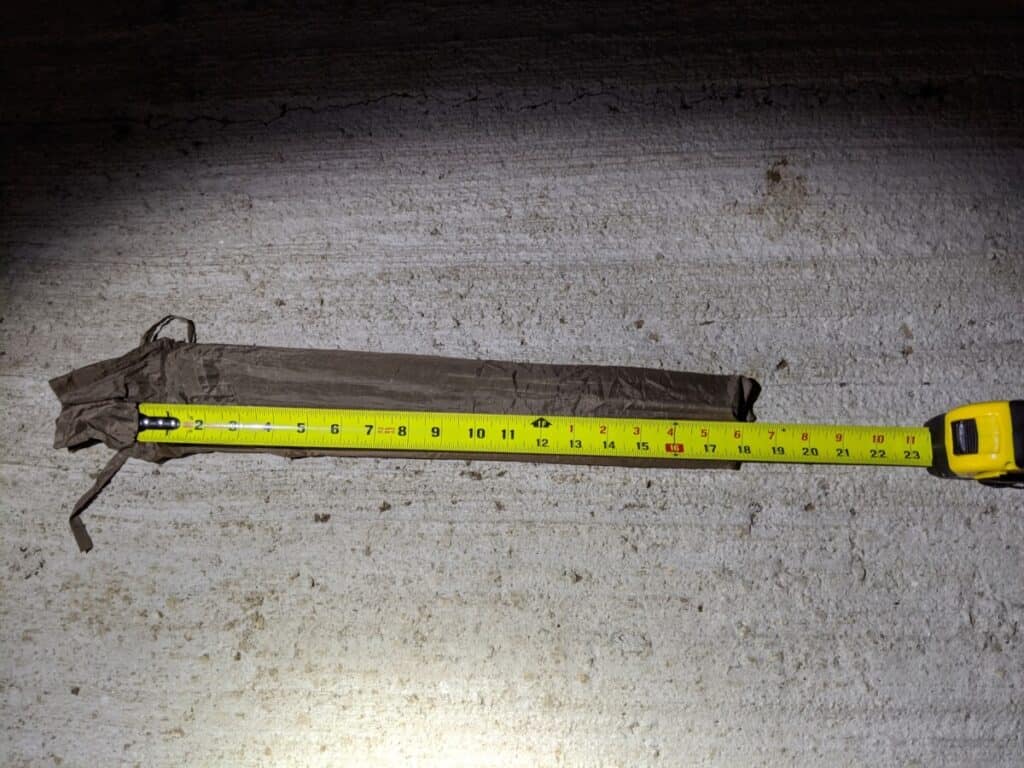When I was growing up we always had to attach our tent to the outside of our backpacks in order to get them to fit. It wasn’t until later in life when I found out that you actually store your tent inside your pack.

1 to 2 person backpacks can be stored easily within a backpack of at least 3400 cubic inches, or 55 liters. Bigger tents are still possible to be carried within a backpack but you may need to distribute the load among several backpacks.
The question is why would you want to do so? I’ll explain which types of tents you can do this as well as some reasons why you would want to put your tent inside your backpack.
By the way, as an Amazon Associate, I earn when buying qualified products through links on my site.
Is It Possible To Fit a Tent Within A Backpack?
I have a Kelty Grand Mesa 2-person tent. I love this tent as it’s worked wonderful for backpacking and for car camping. (See here for a more in depth review or you can check it out here on Amazon) And I can tell you definitively–yes, this tent fit easily within my 4600 cubic internal frame inch backpack. This includes the optional ground tarp, the tent stakes, the tent poles, the tent itself, and the rainfly and guylines.
For this particular tent you could definitely fit it within a smaller backpack but you would lose some storage space that you might want for other necessary items.
The Kelty Grand Mesa, though, is a backpacking tent. This means that the tent poles are made of a lightweight aluminum and can fold compactly. I measured the tent pole length while folded and they are 18 inches long. I would recommend the main compartment to be a few inches longer just so the poles aren’t stressing the backpack fabric.
The “long pole” that determines whether you can fit your tent in your backpack entirely is in fact the tent poles.
When I was growing up we always had to attach our tent to the outside of our backpacks in order to get them to fit. It wasn’t until later in life when I found out that you actually store your tent inside your pack.

If, however, you’re carrying a larger tent, then you have to be more careful. For example, our Core 6-person tent (not a backpacking tent) has tent poles that are each 25 inches long. This tent is far too big for one backpack.
For reference, my Teton Outfitter 4600 (cubic inches) backpack was about 30 inches from the bottom of the biggest compartment all the way to the top.

So, if you want to put your tent in your backpack, you need to make sure that the length of the largest backpack compartment exceeds the pole height by a few inches.
So, before we continue, though, let’s think more about the question: why would you want to put your tent in your backpack?
Should You Put Your Tent Inside Your Backpack?
So putting your tent in your backpack has some distinct advantages and disadvantages. Let’s talk about them:
Advantages
- Rain Protection: Although your backpack is not waterproof without a tarp or other protection, if it drizzles for a few minutes while you’re hiking than your tent will stay dry. Setting up a cold wet tent is not very inviting at the end of your hike.
- Snag Avoidance: When you’re backpacking, you have from 30-80 extra pounds on your back. You’re basically a lumbering elephant at this point–your coordination is significantly decreased. Because of this, as you swing from side to side stepping over logs and such, it’s easy to get your backpack and any attached gear (like your precious tent) snagged (and torn) on branches. If your tent is in your pack you avoid this problem.
- One less bungee cord: One disadvantage of attaching your tent to the outside of your backpack is that you have to think about how to attach things to the outside of your pack. Sometimes your backpack has enough straps to make this work–but sometimes it doesn’t and you need to use bungee cords
Disadvantages
- Tents are bulky: So… this is kind of true. A backpacking 2-person tent can be packed very small, but it requires some anti-laziness (which I often lack). If you stuff your tent inside the tent bag (or just simply inside your backpack), then that means that your other gear is going to be more cramped and when you need to fish something out of your pack you will have to fight through your tent.
- Your tent might not fit: If your tent is over 5-6 pounds, there’s a chance it won’t fit in your backpack. Generally if your tent is around 4 or 5 pounds, then it will fit in an adult-sized backpack. If your tent is a 4-person or a 6-person, you may have to split up the tent material (rainfly, tent stakes, etc) among several backpackers.
Tips For Putting a Tent Inside Your Backpack
Before you stuff your tent in your backpack and go on your merry way, here’s a few tips to ensure your tent doesn’t get damaged and that you have plenty of room in your backpack.
- Combine the lower and main compartments: The lower compartment (the pocket at the bottom of the backpack that usually has separate zippers) often can be combined with the main compartment. If you’re having trouble getting your poles to fit, you can partially open the gap between the lower compartment and the main compartment so your poles can lay vertically in the backpack.
- Fold your ground cloth flat against the internal frame: I use a simple tarp for my ground cloth and I have found that everything fits a lot better if this tarp is as flat as possible against the actual frame of the backpack. In other words, the tarp should be as flat and as close to your back as possible on the inside of the backpack.
- Tightly roll your tent: Folding a tent tight like a flag can lead to sharp folds which can damage the waterproof lining of the tent and cause issues. It’s best to lightly fold and roll. I’ve gotten away with stuffing my tent in my tent bag but I hear that’s not the best for it.
- Don’t pack your tent wet: This is true in general (sometimes it can’t be helped), but it’s especially important if you are going to be putting your tent in your backpack to make sure you dry it as much as possible. When you get home you should empty your pack (it’s easy to just leave everything in there because you just finished an exhausting hike) and let your tent dry out. See more information on why it’s so important to dry your tent and some tips for fast drying here.
Types of Tents You Can Fit Inside a Backpack
I covered this spread out through the article but if you are looking for the specific consice answer, here it is. Nevery tent is going to fit inside your backpack, not matter how big your backpack is.
If you want to fit your tent in a backpack, here are some key components and key words you should look for:
- Backpacking tent
- Ultralight
- 1-2 person
- Aluminum poles
- Less than 5-6 pounds
My Kelty Grand Mesa 2 person wasn’t advertised as ultralight, but it is definitely lightweight enough and compact enough to fit inside a backpack.
Ultralight tents are incredible in their portability. This Zpacks Plexamid Tent (see it at their website, here.) weighs less than a pound. Incredible! Anyway, this will fit inside your backpack no problem.
Tarp shelters (like this one from ZPacks) weigh about 6 ounces and can be used as your sole shelter (popular for those who are serious campers and into bushcraft). If you are planning on making a shelter with just a tarp, than you will be able to fold it small enough to fit inside your pack.
Anything bigger than 5-6 pounds it’s likely you will need to split up the tent among multiple people to be able to haul it inside multiple packs.
Types of Backpacks Ideal For Stuffing a Tent Inside
Again, I mentioned a lot of this information earlier, but if you want your tent to fit in your pack, make sure you get a pack with the following:
Minimum size of around 3400 Cubic Inches, or 55 liters (usually this number is in the model name of the backpack)–much smaller than this and you will need ultralight or extremely compact tents to fit inside these packs..
